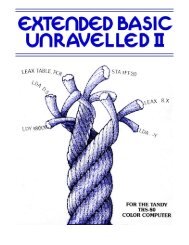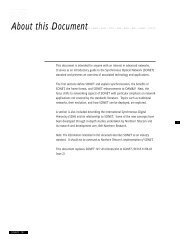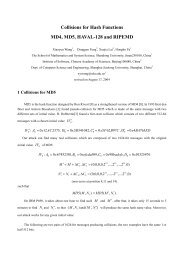The Keyed-Hash Message Authentication Code (HMAC) (FIPS-198 ...
The Keyed-Hash Message Authentication Code (HMAC) (FIPS-198 ...
The Keyed-Hash Message Authentication Code (HMAC) (FIPS-198 ...
You also want an ePaper? Increase the reach of your titles
YUMPU automatically turns print PDFs into web optimized ePapers that Google loves.
K 0Lopadttextx’N’bits.<strong>The</strong> key K after any necessary pre-processing to form a B byte key.Block size (in bytes) of the output of the Approved hash function.Outer pad; the byte x’5c’ repeated B times.<strong>The</strong> number of bytes of MAC.<strong>The</strong> data on which the <strong>HMAC</strong> is calculated; text does not include the padded key.<strong>The</strong> length of text is n bits, where 0 ≤ n < 2 B - 8B.Hexadecimal notation, where each symbol in the string ‘N’ represents 4 binary|| Concatenation⊕Exclusive-Or operation.3. CRYPTOGRAPHIC KEYS<strong>The</strong> size of the key, K, shall be equal to or greater than L/2, where L is the size of thehash function output. Note that keys greater than L bytes do not significantly increase thefunction strength. Applications that use keys longer than B-bytes shall first hash the keyusing H and then use the resultant L-byte string as the <strong>HMAC</strong> key, K. Keys shall bechosen at random using an Approved key generation method and shall be changedperiodically. Note that the keys should be protected in a manner that is consistent with thevalue of the data that is to be protected (i.e., the text that is authenticated using the<strong>HMAC</strong> function).4. TRUNCATED OUTPUTA well-known practice with MACs is to truncate their output (i.e., the length of the MACused is less than the length of the output of the MAC function L). Applications of thisstandard may truncate the output of <strong>HMAC</strong>. When a truncated <strong>HMAC</strong> is used, the tleftmost bytes of the <strong>HMAC</strong> computation shall be used as the MAC. <strong>The</strong> output length, t,shall be no less than four bytes (i.e., 4 ≤ t ≤ L). However, t shall be at least 2L bytes (i.e.,2L ≤ t ≤ L) unless an application or protocol makes numerous trials impractical. Forexample, a low bandwidth channel might prevent numerous trials on a 4 byte MAC, or aprotocol might allow only a small number of invalid MAC attempts. See Appendix B.3






